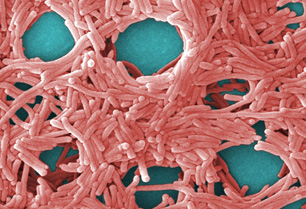Legionella
| EPA Maximum Contaminant Level Goal (MCLG) |
zero |

Legionella pneumophila
Legionella are a group over 40 species of small, rod-shaped bacteria responsible for Legionellosis. The most common species present in human infections is Legionella pneumophila—pneumophila is latin for “lung-loving”—found worldwide in a variety of natural and artificial water sources. These infections can occur in two forms: the milder, flu-like Pontiac Fever, or Legionnaire's Disease, a potentially fatal form of pneumonia.
Legionella thrive in water, especially warm water, and have been found in natural sources and homes, cooling towers, fountains, spa pools, hotel water systems, ships, factories, and respiratory equipment.
Health Effects of Legionella
Pontiac Fever (febrile illness), is the less-severe, flu-like form of the infection, characterized by fever, chills, headache, and muscle pain. This infection typically clears within 2 to 5 days.
Legionnaire's Disease is the more severe form, involving pneumonia. Its symptoms are nonspecific, but the infection has a rapid onset and can be fatal.
Water Treatment for Legionella
Legionella can be effectively treated through heat and flow-rate management, ultrafiltration and ultraviolet irradiation.
Sources: EPA, WHO, Photo: WikiMedia, author: Janice Haney Carr; provided by CDC/ Margaret Williams, PhD; Claressa Lucas, PhD;Tatiana Travis, BS
Site Index
Filtration Systems
- Aeration for Iron & Sulfide
- Backwashing Filters
(whole house & well units)
- Chlorine & Chemical Injectors
- Countertop Water Filters
- Emergency Filters
- Garden Hose Filters
- Reverse Osmosis, Residential
- Reverse Osmosis, Commercial
- Shower Filters
- Specialty Filters
- Ultraviolet Systems
- Undersink Filters
- Water Softeners
- Whole House Filters
Cartridges
Parts
- Replacement Parts
- Faucets
- Filter Media
- Fittings
- Housings
- O-rings
- Pumps
- Pura UV
- R.O. Parts
- R.O. Tanks
- R.O. Booster Pump
- VIQUA UV